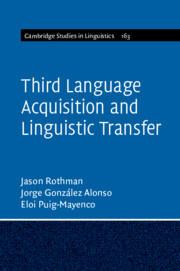Book contents
- Third Language Acquisition and Linguistic Transfer
- Cambridge Studies in Linguistics
- Third Language Acquisition and Linguistic Transfer
- Copyright page
- Dedication
- Contents
- Figures
- Tables
- Acknowledgments
- 1 Setting the Context
- 2 Theoretical Approaches to Sequential Multilingualism
- 3 Multilingual Lexis (Acquisition and Processing) and Phonology
- 4 Transfer in Multilingual Morphosyntax
- 5 A Review of Published Work
- 6 Moving On and Going Forward in L3/Ln Acquisition
- Appendix A
- Appendix B
- Appendix C
- References
- Index
4 - Transfer in Multilingual Morphosyntax
Published online by Cambridge University Press: 07 October 2019
- Third Language Acquisition and Linguistic Transfer
- Cambridge Studies in Linguistics
- Third Language Acquisition and Linguistic Transfer
- Copyright page
- Dedication
- Contents
- Figures
- Tables
- Acknowledgments
- 1 Setting the Context
- 2 Theoretical Approaches to Sequential Multilingualism
- 3 Multilingual Lexis (Acquisition and Processing) and Phonology
- 4 Transfer in Multilingual Morphosyntax
- 5 A Review of Published Work
- 6 Moving On and Going Forward in L3/Ln Acquisition
- Appendix A
- Appendix B
- Appendix C
- References
- Index
Summary
The aim of this chapter is to offer the reader a panoramic yet comprehensive view of the theoretical issues and models that have attracted the most attention within generative approaches to L3/Ln morphosyntactic acquisition, with a particular emphasis on how transfer selection from previously acquired languages is hypothesized to apply. To the best of our ability, all models will be treated in an equal fashion. This does not mean that the description of each model will have or could possibly have the same level of detail, for justifiable reasons. To begin, models have appeared at different times, which correlates with more or less temporal opportunity to have been tested and to have gathered a critical mass of evidence. Moreover, not all models have had an equal amount of support from the published literature – a detailed analysis of which is the focus of Chapter 5 – and/or have had the same level of updating by their authors over time.
Keywords
- Type
- Chapter
- Information
- Third Language Acquisition and Linguistic Transfer , pp. 116 - 187Publisher: Cambridge University PressPrint publication year: 2019
- 1
- Cited by



